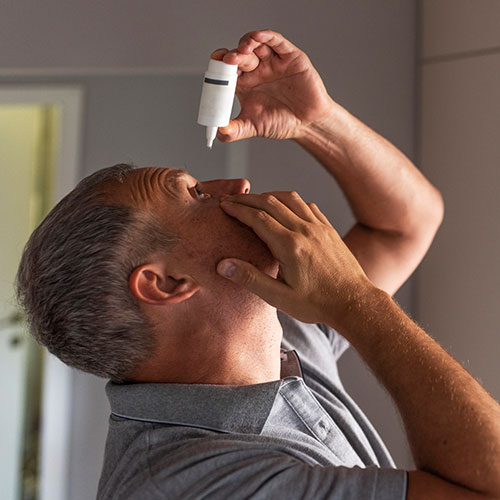Dry Eye & MGD Treatment
Burning, itching or redness in the eyes. Many people who don’t consider themselves to be ‘Dry Eye Sufferers’ are still all too familiar with the usual dry eye symptoms.
What's causing my Dry Eyes?
Generally, there is dysfunction in the Meibomian gland with dry eyes. Meibomian glands are responsible for the supply of meibum, an oily substance that gives nutrition to the eye’s surfaces and prevents the evaporation of the eye’s tear film. Unfortunately, the Meibomian glands can become clogged, blocking these naturally secreted lubricating oils from properly coating the eye causing the moisturizing tear film to evaporate quicker and the eyes to get itchy, burning and red.
Meibomian Gland Dysfunction (MGD) causes the lipid layer to be disrupted which can lead to dry eye. Without an adequate lipid layer, the rate of evaporation of the tears from the surface of the eye is excessive, resulting in ocular dryness. Evaporation is the primary cause of nearly 90% of dry eyes.
Katmai Eye and Vision Centers Dry Eye treatments use numerous treatment modalities including Lipiflow, Intense Pulsed Light (IPL) therapy and TempSure RF therapy.

What's Causing my Dry Eyes?
Generally, there is dysfunction in the Meibomian gland with dry eyes. Meibomian glands are responsible for the supply of meibum, an oily substance that gives nutrition to the eye’s surfaces and prevents the evaporation of the eye’s tear film.
Unfortunately, the Meibomian glands can become clogged, blocking these naturally secreted lubricating oils from properly coating the eye causing the moisturizing tear film to evaporate quicker and the eyes to get itchy, burning and red.
Meibomian Gland Dysfunction (MGD) causes the lipid layer to be disrupted which can lead to dry eye. Without an adequate lipid layer, the rate of evaporation of the tears from the surface of the eye is excessive, resulting in ocular dryness. Evaporation is the primary cause of nearly 90% of dry eyes.
Katmai Eye and Vision Centers Dry Eye treatments use numerous treatment modalities including Lipiflow, Intense Pulsed Light (IPL) therapy and TempSure RF therapy.
LipiFlow® for Dry Eye and MGD
The LipiFlow® Thermal Pulsation System is a breakthrough technology for treating dry eye and associated meibomian gland dysfunction. For many patients, LipiFlow® makes the difference between endless suffering and substantial relief of the discomfort of dry eye.

How Does LipiFlow® Work?
The most common cause of meibomian gland dysfunction is obstruction and blockage of the ducts and openings of these glands. By restoring or improving the lipid layer, the rate of evaporation can be dramatically decreased and relief from dry eye can be significant.
The oily tears provide a protective surface covering the front of the eye the surrounding tissues. The meibomian glands in both upper and lower lids secrete small quantities of a complex lipid into the tears with every blink. This lipid layer provides nutrition, prevents tear evaporation and stabilizes the tear film. The LipiFlow Thermal Pulsation System is a 12 minute in-office procedure that gently heats the eyelids and massages the built up meibum out of the obstructed Meibomian glands, restoring normal function and tear stability.

How Does LipiFlow® Work?
The most common cause of meibomian gland dysfunction is obstruction and blockage of the ducts and openings of these glands. By restoring or improving the lipid layer, the rate of evaporation can be dramatically decreased and relief from dry eye can be significant. The oily tears provide a protective surface covering the front of the eye the surrounding tissues.
The meibomian glands in both upper and lower lids secrete small quantities of a complex lipid into the tears with every blink. This lipid layer provides nutrition, prevents tear evaporation and stabilizes the tear film. The LipiFlow Thermal Pulsation System is a 12 minute in-office procedure that gently heats the eyelids and massages the built up meibum out of the obstructed Meibomian glands, restoring normal function and tear stability.
IPL Treatment for Dry Eye
IPL or Intense Pulsed Light therapy derives from dermatology where it has been used for several decades to treat a variety of conditions including facial rosacea, vascular and pigmented skin lesions, as well as for skin rejuvenation. More recently, IPL has been shown to be extremely effective for managing meibomian gland dysfunction, dry eye and the ocular forms of rosacea.
The treatment’s purpose is to remove inflammatory process causing the itching, burning and redness of the eyes. We utilize a state-of-the-art Lumenis Optima® M22 which is considered a standard of care device.
Treatment is accomplished in 3-4 sessions scheduled approximately 2-4 weeks apart. IPL is applied to the skin surrounding the eyes while wearing specialized protective eye shields. Sessions last about 10 minutes and are quite comfortable.
IPL works by regressing abnormal blood vessels that leak inflammatory elements into the ocular tissues, improving meibomian gland function, tear stability and patient comfort. Results are usually seen by the second or third treatment and have been extremely impressive for the majority of patients. Retreatments may be performed in six months to a year if necessary.
IPL also treats the abnormal, surface telangiectatic blood vessels found with rosacea, an inflammatory condition of the skin’s sebaceous glands. The same telangiectatic blood vessels are present in the eyelids and periorbital area of patients with ocular rosacea. IPL reduces bacterial overgrowth and Demodex on the eyelids, reducing inflammation and redness of the eyes and eyelids.
Make your appointment today with either Dr. Sheryl Lentfer or Dr. Laura Sifferman Kompkoff.
